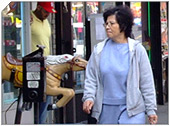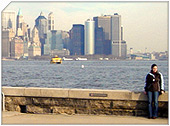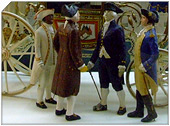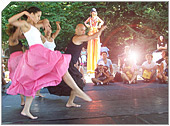Five Points, Manhattan, New York City
|
Getting Started
Index
NYC Neighborhoods
Manhattan
Brooklyn
Queens
Bronx
Staten Island
NYC Icons
Chrysler Building
Flatiron Building
Empire State Building
Safe NYC
NYPD
FDNY
NYC Weather
NYC Climate
NYC Weather Forecast
Winter Season
Spring Season
Summer Season
Fall Season
NYC History & Politics
New York City History
Tammany Hall and Politics
New York City Politicians
New York City Personalities
Culture of Gotham City
Culture of the city
Cultural diversity
City in popular culture
|
Five Points (or The Five Points) was a notorious slum centered on the intersection of Worth St. (originally Anthony St.), Baxter St. (originally Orange St.) and a now demolished stretch of Mosco St. (formerly Park St.) on Manhattan island, New York City, New York, in the United States. The name Five Points derived from the five corners at this intersection.
The neighborhood was the subject of Martin Scorsese's 2002 film Gangs of New York, and Herbert Asbury's 1928 book The Gangs of New York.
History
The neighborhood took form by about 1820 next to the site of the former Collect Pond, which had been drained due to a severe pollution problem. The landfill job on the Collect was a poor one, and surface seepage to the southeast created swampy, insect-ridden conditions resulting in a precipitous drop in land value. Most middle and upper-middle class inhabitants fled, leaving the neighborhood open to the influx of poor immigrants that started in the early 1820s and reached a torrent in the 1840s due to the Irish Potato Famine.
At Five Points' height, only certain areas of London's East End vied with it in sheer population density, disease, infant and child mortality, unemployment, violent crime, and other classic ills of the destitute. It was the original melting pot, at first consisting primarily of newly emancipated African Americans (gradual emancipation ended in New York in 1822), and newly arrived Irish. The confluence of African, Irish, Anglo and, later, Jewish and Italian culture, seen first in Five Points, would be an important leavening in the growth of the United States.
The rough and tumble local politics of "the old Sixth ward", while not free of corruption, set important precedents for the election of non-Anglo-Saxons to key offices. Although the tensions between the African Americans and the Irish were legendary, their cohabitation in Five Points was the first large-scale example of grassroots racial integration in American history, and arguably the first in world history (where both parties came to it of their own volition). In the end, the Five Points African American community moved to Manhattan's West Side and to the then undeveloped north of the island, but the years spent pursuing daily life alongside the Irish in Five Points and, later, alongside Jews and Italians in the same neighborhood, helped create a sense of common purpose among these minorities which even today manifests itself in the liberal wing of the American political spectrum, most noticeably in the Democratic Party.
|
New York City Search
Quick NYC
|
|
|
 How safe is New York City?
How safe is New York City? Contrary to popular belief, the City consistantly ranks in the top ten safest large cities in the United States. The NYPD is the largest municipal police force in the world and has it's own Movie/TV Unit. |

New York has a humid continental climate resulting from prevailing wind patterns that bring cool air from the interior of the North American continent. New York winters are typically cold with moderate snowfall.  New York Weather Forecast New York Weather Forecast |

New York's two key demographic features are its density and diversity. The New York City metropolitan area is home to the largest Jewish community outside Israel. It is also home to nearly a quarter of the nation's South Asians, and the largest African American community of any city in the country.  Ethnic composition Ethnic composition |

New York Newspapers
 
|



 New York Weather Forecast
New York Weather Forecast
 Ethnic composition
Ethnic composition


















